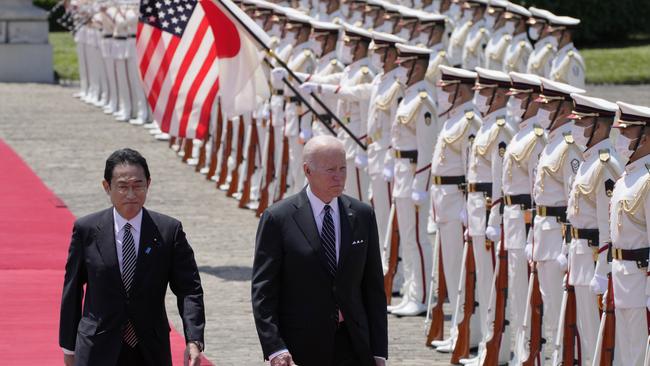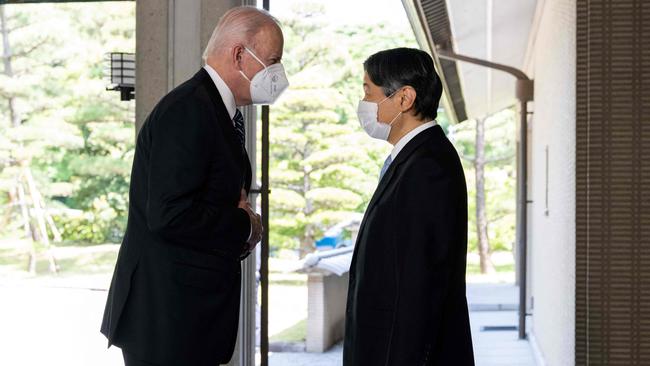Biden kicks off economic group linking US and Asia
Indo-Pacific Economic Framework doesn’t include plans to lower tariffs, disappointing some nations.

President Biden and leaders from a dozen countries in the Indo-Pacific region on Monday endorsed a new economic platform meant to counter China’s influence through co-operation on global issues such as supply chains, clean energy and digital rules.
The Indo-Pacific Economic Framework marks the Biden administration’s most ambitious attempt to build economic ties with Asian nations after the US under then-President Donald Trump pulled out of the Trans-Pacific Partnership in 2017. US officials said the framework represented a new approach to co-operation that moves beyond a traditional trade agreement.
But unlike the TPP, which went into effect in late 2018 without US participation, the new group doesn’t include plans to negotiate lower tariffs or broad steps to clear away barriers to market access.
“The key problem for Biden in Asia is that he is constrained by the domestic politics of trade in the United States,” said Neil Thomas, a China analyst at the political risk consulting firm Eurasia Group. “What countries in Asia want is precisely what Biden cannot give: greater access to the US market.” US Trade Representative Katherine Tai said the Biden administration took a realistic approach to Asian economic co-operation. “I think there is a very, very strong lesson there that TPP, as it was envisioned, ultimately was something that was quite fragile,” she said. “Trade is an important component to this, but not the only component.” The White House said the nations in the new framework collectively represent about 40% of global gross domestic product. US allies Japan and South Korea joined the group as well as seven nations in the 10-nation Association of Southeast Asian Nations: Brunei, Indonesia, Malaysia, the Philippines, Singapore, Thailand and Vietnam. In addition, India, Australia and New Zealand joined.
Mr Biden held a summit in Washington last week with Asean leaders, in part to pitch the framework. Administration officials said other nations could join later. A US official said the administration was in discussions with at least one other nation about joining.
The initial rollout didn’t include Taiwan, whose inclusion could cause further friction with China and draw opposition from some participants leery of upsetting Beijing. More than 50 US senators wrote a letter to Mr Biden last week encouraging him to include Taiwan in the pact.
One challenge for the new group is coexisting with the TPP, which includes Japan and several Southeast Asian nations. Japanese Prime Minister Fumio Kishida said Monday that he hoped the US would come back to the TPP, saying this would have strategic value by linking the US more closely to Asia.
That hope looks unrealistic in Washington, where any sweeping Pacific Rim trade agreement would face major hurdles to passage in Congress. The new framework won’t require congressional approval, but the Biden administration will work with lawmakers in building it, a US official said.

The TPP and other tariff-lowering trade deals have had some supporters in the US, such as businesses and farmers who hope to export more to Asia. Some in Congress have expressed frustration that the new Indo-Pacific group won’t necessarily bring quick benefits for US exporters.
US officials said the framework centres on four pillars: co-operation on digital trade; improving the resiliency of supply chains; ramping up clean energy; and putting in place strong tax, anti-money-laundering and antibribery measures.
Member countries can choose which of these areas they participate in, one of the US officials said, a concession that helped bring to the table nations who were sceptical about some components of the deal. The Biden administration hopes members will decide which elements of the agreement they will sign on to by mid-June. After that, negotiations will begin over the scope of each pillar, the official said.
The digital-trade portion of the framework could be modelled in part on a digital agreement signed during the Trump administration between the US and Japan, though it is likely to include more stringent labour and environmental provisions, the US official said. The US is hoping to discuss with member countries new rules governing cross-border flow of digital goods, from ebooks to the crafts people make on Etsy.
Commerce Secretary Gina Raimondo, who joined Mr Biden and Ms Tai in Tokyo for the announcement, said it would offer Indo-Pacific countries “an alternative to China’s approach to these critical issues.” Beijing expressed scepticism about the framework before it was released. “It should not target third parties or undermine their interests, and should not be decidedly selective or exclusive,” Chinese Foreign Ministry spokesman Wang Wenbin said last week.
Jake Sullivan, Mr Biden’s national security adviser, said past agreements didn’t address the issues on which the new group is focusing. “We believe that we need a new model that we can move on quickly,” Mr Sullivan said.
The new framework includes not just wealthy democracies and US allies such as Japan and Australia but also large emerging countries such as India, Indonesia and Vietnam, accomplishing one of the Biden administration’s goals.
To entice these countries to join the launch, the framework released on Monday is broad and avoids provocative statements about China, the top trading partner for many in the region.
There is no language that suggests the framework aims to confront autocratic governments and nonmarket economies such as China and Russia. It also lacks any condemnation of Russia’s invasion of Ukraine, which could have drawn opposition from India, with its strong political and military ties to Moscow.
In contrast, the US-EU Trade and Technology Council, a new forum Washington launched last year with the European Union, makes countering nonmarket economies a key part of its mission. Officials involved in the council say the group has already helped advance aggressive sanctions against Moscow.
Alex Leary in Washington contributed to this article.
The Wall Street Journal



To join the conversation, please log in. Don't have an account? Register
Join the conversation, you are commenting as Logout